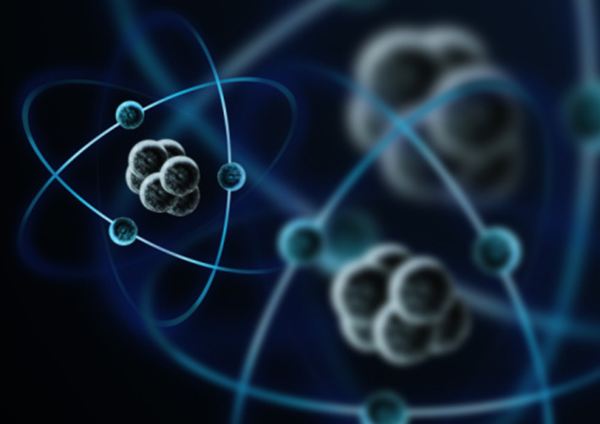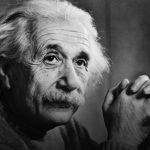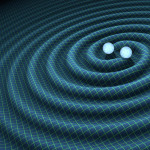Quantum Physics and Bodily Resurrection
by Matthew Allen Newland
Filed under Science, The Resurrection
The Question
In the year 587 BCE, the Babylonians destroyed Jerusalem and brought many of the Jews back home as captives. Among them was the prophet Ezekiel. During this dark period of Israel’s history, God promised Ezekiel that Israel would rise again. We can read about it in the Book of Ezekiel, where God leads His prophet out to a battlefield in a valley, strewn with the dry, dusty skeletons of Jerusalem’s fallen army. There, God makes Ezekiel a strange request: He tells him to command the bones to live again. Ezekiel does as God says (telling his silent audience to “Hear the word of the Lord!”), and as his voice echoes through the valley, the earth begins to shake. The scattered bones reassemble themselves, and are covered with knotted lines of sinew. Over them grow new layers of flesh, skin, and hair. The breath of God, carried by the wind, blows over the bodies, and just as breath animated Adam, so too do the rebuilt bodies lying on the dust of the battlefield rise up, awake. By the power of God, “a great and immense army” now stands on its feet. Israel will rise again (Ez. 37:1-14).
The Bible offers many other examples of death and resurrection, written in the centuries following Ezekiel’s vision of the dry bones. There is the resurrection of Lazarus (John 11:38-44), the dead saints who emerged from their tombs at the hour of Jesus’ death (Matt. 27:52), and of course Jesus himself (Mark 16:9, John 20:14). These are all easy enough for us to picture in our minds; Lazarus and Jesus were both dead for only a very short time, their bodies bound up securely in folds of linen. Though Lazarus’ family had feared a stench when Jesus asked that his tomb be opened up, we can still imagine some process reversing his dead state or somehow rejuvenating him. The same goes for the dead arising in the tombs in St. Matthew’s gospel; though perhaps dead for many years, their bodies had remained undisturbed in their tombs until the day of Jesus’ death. And the same is true for the bones in Ezekiel's vision: Though the dead men Ezekiel saw being raised up were nothing but dust and dried bone, the remains of those soldiers slain on that battlefield remained (more or less) together.
The Challenge
Christianity is predicated on the possibility of resurrection, and the belief that on Easter, Jesus defeated death once and for all. More than that, He had the power to extend His new life to others, allowing them to share in His immortality. This is why, once the early persecutions of the Christians were underway, the Romans went to great lengths to discourage the belief in bodily resurrection. According to Eusebius of Caesarea, one group of Christians executed by the Romans had had their corpses left to rot for a week, unburied (so that they would be denied proper funerals). The remains were then cremated, and finally dumped into the Rhone River. As the ashes washed downstream, one of the overseers remarked aloud, “Now let us see if they will rise again!”
While the Romans might have worked hard to destroy the bodies of Christians, they really need not have bothered. In reality, just as human remains decay, so too do they disperse. In the valley Ezekiel saw in his vision, birds of prey would have already picked the bones of Jerusalem clean, carrying parts of the dead soldiers away with them in their beaks and bellies. And if the bones had remained lying there longer, they would have eventually crumbled into dust and been blown away in the wind, or washed out by the rain.
Now, think of all the people who have ever lived, and what has become of most of them over the past 200,000 years. Their tombs are lost, their bones long gone, consumed by predators, floods, landslides, at the mercy of the elements, or (perhaps) lying beneath the foundations of modern cities. With a very few exceptions (such as the Pharaoh Tutankhamen, whose untouched tomb was discovered in 1922, some 3,200 years after he was laid to rest) the inevitable, natural process of decay has utterly destroyed what remains of anyone who lived more than a few centuries ago. The Romans of Lyon need not have tried so hard!
Atheists are right to point out that this poses a serious problem for most Catholics alive now, who hope for resurrection and eternal life in the future. There are of course exceptions, examples of people who lived long ago, whose bodies remain intact until today: Pharaoh Tutankhamen, of course, the bog-people preserved in the medieval swamps of northern Europe, and the incorrupt bodies of a few special saints. But what about the rest of us? Our remains might one day be scattered across the planet, be consumed by worms, fertilize the grass, be consumed by cows, and be consumed by eaters of hamburgers.
If Catholics really believe in the possibility of resurrection, and wish to convince atheists that death is not the end of life, they must find a satisfying answer to this question. Explaining the "mechanics" of resurrection indeed poses a formidable challenge.
A Possible Solution
In 1935, Albert Einstein and two of his younger colleagues, Boris Podolsky and Nathen Rosen, proposed one of the most famous thought experiments in modern physics. The paper they wrote (with the lengthy title, "Can Quantum-Mechanical Description of Physical Reality Be Considered Complete?") describes a quality of physical reality known as "locality". Because of locality (location in the physical world), a domino at the front of a line cannot directly knock down a domino at the end of the end; it can only do so indirectly (via the movement of all the dominoes standing in between).
In the EPR paper (so named because of the initials of its authors), though, a perceived "fatal flaw" of quantum physics is revealed, in which locality plays a crucial role. But it is, in fact, not a flaw at all—it is a mystery! The paper describes a bizarre paradox that seemingly flies in the face of common sense (a paradox upon a paradox, as those familiar with Schrodinger's cat already know), yet which has been since verified many times in the laboratory.
To explain the paradox, let's keep talking about dominoes. Suppose I randomly take two dominoes from a pile and look at the number of dots on each. Let us say one has no dots at all, and the other has twelve. I shake the two dominoes in my hands, mix them up, and then look at the one on top. I see that it is the one that has twelve dots, and automatically know (even though I am not looking at it) that the one I cannot see has no dots.
This makes sense, until we start thinking about a similar situation on a quantum level. A quantum particle called a pi meson decays into a positron and an electron, which spin off in opposite directions. But their spins are not independent; they correlate with the original state of the pi meson before its decay. As a result, a physicist observing the electron will automatically know the state of the positron, just as I (in the above example) can tell you the number of dots on the domino I cannot see, so long as I am looking at the other one.
How is this a paradox? Well, in quantum physics (and the example of Schrodinger's cat), the state of a particle depends upon the presence of an observer. The properties of a particle (its position and momentum, for example) are undefined until an observer observes them (like Doctor Who's Weeping Angels, who have no definite, solid existence unless they are being watched ... don't blink!). Particles have no definite position or momentum until they are observed, yet by observing the electron a physicist can also know the state of a positron. Einstein, Podolksy, and Rosen, then, had apparently found a contradiction within quantum theory: the properties of particles really do exist, even if no one is looking at them.
The only other possibility would be what Einstein called "spooky action at a distance": the idea that an observation here can affect reality there. But that would be impossible, Einstein, thought, because of locality (just as knocking over a domino at this end of the line does not directly cause a domino to fall at that end of the line).
Or is it?
As I said already, this "spooky action" has been empirically verified many times in the 80 years since the EPR paper was written, perhaps most effectively by the Swiss physicist Niculus Gisin and his colleagues at the University of Geneva. In 1997, they sent pairs of entangled photons through a network of fiber-optic tubes to locations eleven kilometers apart, one north and the other south of Geneva. And yet even at that distance (keep in mind that these are subatomic particles!), the behaviour of one particle correlated with the behaviour of the other; when the paths of each member of the pair were compared, they were symmetrical. Though there had been many possible pathways through the tubes, what one particle had done, the other had done as well. Even though the two particles were separated by a large distance and had no way of influencing with or "communicating" with one another, the movement of one affected the movement of the other, from a distance.
This is the phenomenon of entanglement. Entanglement occurs constantly, everywhere. While we do not consciously perceive it with our senses, it nevertheless ties together all the most fundamental particles composing reality. Whenever two things, whether photons (light particles), electrons, or atoms interact, they are tied together, sharing a single "experience" and losing their separate existence. On the everyday, human level, these entanglements do not endure for very long; in our bodily experience, new interactions inevitably occur, resulting in new entanglements of new, shared experience. But these interactions have been observed and tested on both microscopic particles and macroscopic objects.
This shared relationship was demonstrated recently with diamonds large enough to be seen by an unaided eye. Physicist Ian Walmsley and his colleagues at the University of Oxford were able to cause two diamond strips to vibrate simultaneously across a fifteen-centimeter gap. This may not sound terribly impressive at first, until we realize that the experiment was conducted at room temperature; the heat of the laboratory and the air particles filling the room would have interfered with the entangling connection between the two diamonds (most entanglement experiments deal with atoms or subatomic particles at temperatures approaching absolute zero, in order to prevent atoms from jostling one another. Walmsley’s experiment involved macroscopic objects at, again, room temperature). Ultimately, Walmsley’s experiment showed that the ties of entanglement may continue to bind particles together, on a larger scale and in spite of outside interference.
A Speculative Conclusion
What does this have to do with resurrection? It suggests that particles may somehow remain united, regardless of the amount of space separating them (for entanglement is a non-local phenomenon, unaffected by distance).
This opens the door to two exciting possibilities. First, it is conceivable that a particular living body could continue on in some form, even after it has died and its component particles have decayed and/or physically separated (whether by an earthquake, a stick of dynamite, or a hungry bear). Second, entanglement suggests that particular events leave a lasting “mark” upon their subjects, right down to the subatomic level. Events unite particles together, whether the spin of a progenitor particle (like a pi meson), or (perhaps!) the shared participation in a particular living body.
So the efforts of the Romans to prevent their Christian victims from being raised up might have been fruitless, after all. While much more investigation is required before we can speak more definitely about this sort of thing (investigations which I will leave in the hands of physicists, though I will watch and listen with great interest), quantum entanglement offers a fascinating response to an important challenge posed to the possibility of resurrection.
In the meantime, incorruptible saints, bog bodies, Egyptian mummies, and dry bones will continue to lie in wait.
Related Posts
Note: Our goal is to cultivate serious and respectful dialogue. While it's OK to disagree—even encouraged!—any snarky, offensive, or off-topic comments will be deleted. Before commenting please read the Commenting Rules and Tips. If you're having trouble commenting, read the Commenting Instructions.













